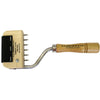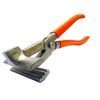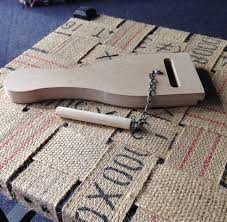A DIY Guide to Web Stretchers
Antonia MarinoA web stretcher is a handy tools essential for installing jute webbing. In this guide, we'll break down what a web stretcher is, why it's crucial for your DIY upholstery projects, and explore the different types available.
A web stretcher is a tool designed to help you pull and secure jute webbing tightly across the frame of your furniture. Jute webbing acts like a support system for the padding and fabric, ensuring your upholstery stays in place for the long haul. Jute webbing is not stretchy like elastic webbing, so its almost impossible to stretch jute taut enough by hand.
Why is a Web Stretcher Essential?
Tight and Even Stretching: A web stretcher allows you to achieve a uniform tension across the jute webbing. This is crucial for preventing sagging or uneven wear on your upholstered furniture, and provides an even base for biconical springs.
Durability: Properly stretched jute webbing ensures that your furniture withstands the test of time, maintaining its shape and support for years to come. Hand stretching may seem tight at first, but once pressure is placed on it the jute will easily sag.
Professional Finish: Using a web stretcher helps you achieve the polished and neat appearance seen in high-quality upholstery. It separates the DIY enthusiast from the novice by providing a more refined finish. For instance, if the jute base under coil springs isn't tight, your seat will not have a even appreance.
Types of Web Stretchers:

Goose Neck Web Stretcher: Named because of the shape of the handle, it is designed for sturdy construction and reliable performance. The goose neck stretcher is great for reaching tight corners and angles, and when the webbing doesn't need to be extremely tight. This is because as it relies more on 'pulling' the webbing rather than 'levering' it.

Paddle & Slot Web Stretcher: This is an affordable stretcher that is a must for every DIY upholsterer as its a good all-rounder. It is easy to use, does not have sharp spikes (!) and and stores easily in the tool box. It provides good leverage for most applications. Its limited flexibility in tight spaces and can only accomodate webbing under 50mm.

Flat Spiked Web Stretcher: This is an economical and efficient tool for stretching webbing over a large surface areas. It has spikes at one end, and either a groove or rubber at the other. The spiked web stretcher is quick to use, especially if you are doing a lot of strips over a large project. It relies on levering so can create a very tight base. It does have limited flexibility in tight spaces.

Stretch Pliers: The benefit of using a pair of stretch pliers is precise control of the stretch, especially in small or intricate areas. It is often used by artist to stretch canvas onto frames. Although this tool does require a bit of practice for optimal use, its certainly comes in hand for web stretching and other tasks.
When choosing the right Web Stretcher consider the specific needs of your upholstery project. If you're working on a piece with many corners, a Goose Neck stretcher might be your best bet. For larger surfaces, a Flat Spiked stretcher could save you time and effort. Stretch pliers are handy for detailed work, while Paddle & Slot stretchers strikes a good balance between versatility and ease of use.


